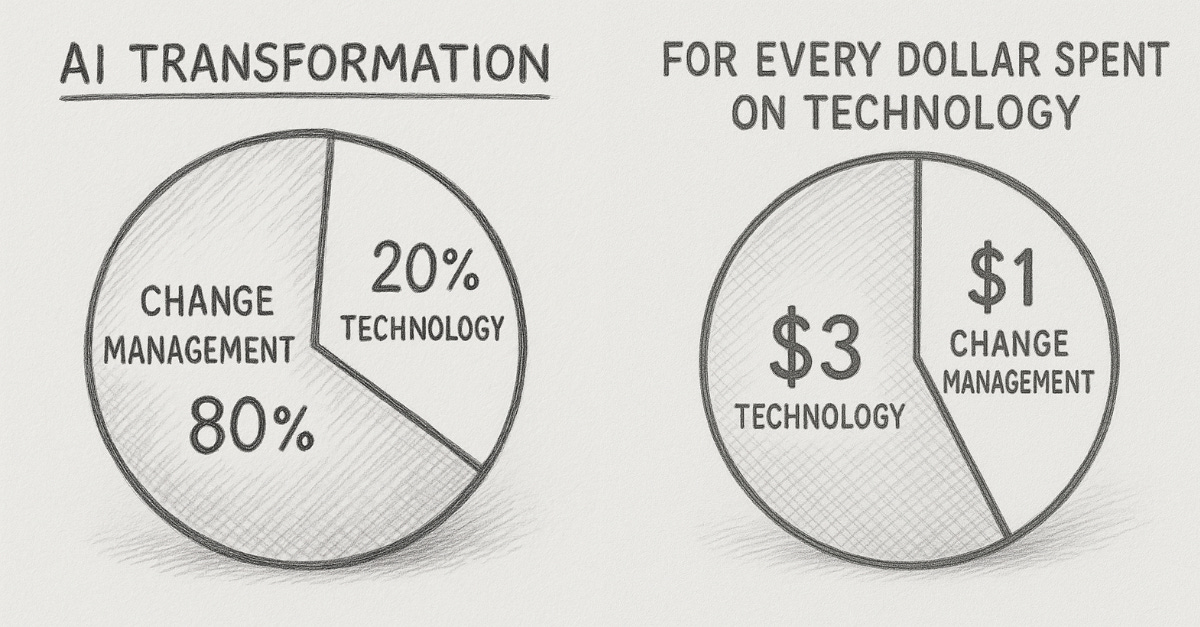Why AI Adoption Isn’t a Tech Project, but Change Management Project
AI success is 80% people, 20% tech. Learn why change management - not code - is the key to AI transformation. Lead the change.
Artificial Intelligence is not simply another wave of technological advancement - it is an inflection point reshaping how businesses operate, compete, and create value. The velocity of change is staggering; in this new era, speed and consistency are the only moats. For leaders, this means the real competitive edge no longer lies in deploying the most advanced algorithms but in orchestrating human adaptability at scale. The organizations that thrive will be those that manage change - rapidly, responsibly, and with purpose.
5 Quick Answers
1. Why is AI change management more important than technology in digital transformation?
AI adoption succeeds when people, not just machines, evolve. Around 80% of AI transformation depends on change management—aligning leadership, culture, and workforce capabilities before introducing new technology.
2. How can business leaders overcome employee resistance to AI adoption in the workplace?
Leaders overcome resistance by building trust through communication and upskilling. Clear messaging that AI enhances—not replaces—human work fosters acceptance and engagement.
3. What are the best change management strategies for successful AI adoption in organizations?
Successful AI adoption blends top-down leadership with bottom-up innovation. Encourage hands-on learning, reward early adopters, and focus efforts on the middle 40% who shape company culture.
4. How can companies improve AI literacy and prepare employees for automation?
Companies boost readiness by making AI literacy a continuous learning priority. Weekly training, role-based workshops, and practice-driven sessions empower teams to integrate AI confidently.
5. What is the best approach to AI governance and ethical risk management for businesses?
Effective governance means being an enabler, not a blocker. Define guardrails for ethics, data privacy, and model transparency while encouraging safe experimentation and innovation.
AI as a Change Management Project, Not a Technical One
While many organizations still frame AI adoption as a technical challenge, the truth is clear: AI transformation is 80% change management and 20% technology. Technology can be purchased; adoption must be earned. Companies that succeed invest disproportionately in the human side - mindsets, skills, and structures. A practical rule of thumb: for every dollar spent on technology, allocate three dollars to change management. This 1:3 ratio ensures that people, processes, and leadership evolve alongside the tools.
Human factors - ego, fear, and uncertainty - are the real barriers to scaling AI. These are the elements of what some call “primate behavior”: our innate resistance to losing control or expertise. Overcoming them demands empathetic communication, transparent leadership, and deliberate design of new habits and incentives.
The Imperative and Pace of AI-Driven Change
The risk of inaction now outweighs the risk of experimentation. AI is hollowing out repetitive and cognitive tasks - the transformation is subtle but pervasive, happening through “termites, not tornadoes.” Jobs are not disappearing overnight but being reshaped piece by piece. Every white-collar profession is experiencing a quiet redefinition of value.
We have moved from an era of digital enablement to an era of digital outcomes. AI doesn’t merely offer better tools; it performs work, makes decisions, and produces results autonomously. Business leaders must therefore accelerate their organizational metabolism - adopting an “always learning” posture and empowering teams to adapt continuously.
Change Management as the Critical Bottleneck
The biggest obstacle to AI success is not the model - it’s the human response to change. Resistance, fatigue, and fear can paralyze even the most promising initiatives. As one executive put it, the bottleneck isn’t technology - it’s primate behavior. Leaders must navigate ambiguity with confidence, not false certainty, providing context, reassurance, and opportunity.
This is why the Chief AI Officer of the future must be a change leader first and a technologist second. Their success depends on partnership with HR and culture leaders to guide reskilling, career pathways, and new definitions of performance. Change management isn’t an add-on; it is the operating system for AI adoption.
Strategies for Driving Adoption
Successful AI integration requires both top-down sponsorship and bottom-up engagement:
Model the behavior: Leaders who actively use AI tools set the tone for the organization. Adoption cascades when people see their managers engaging authentically.
Combine carrots and sticks: Incentivize experimentation but track usage. Recognize champions while addressing persistent resistance.
Target the middle: Focus change efforts on the 30–40% of employees who are open but uncertain. They represent the tipping point between enthusiasm and inertia.
Define the WIIFM (“What’s in it for me”): Clearly articulate how AI will eliminate drudgery, enhance performance, or open new career paths.
The most effective programs blend structured governance with flexibility for local innovation - creating both accountability and agency.
Organizational Learning and AI Literacy
AI literacy is now a life skill. Yet, many professionals still lack even basic understanding of how AI works or how to apply it responsibly. Learning can no longer be episodic; it must be continuous, practical, and engaging.
Make learning a contact sport: People learn AI by doing, not by reading. Encourage hands-on exploration through internal sandboxes and collaborative projects.
Build weekly rituals: Regular, short learning sessions - such as “Fuel Up Fridays” - help normalize ongoing education.
Shift from prompting to agent creation: Move beyond using AI for simple queries toward designing and supervising autonomous agents.
Teach navigation over memorization: The next generation of education and training must focus on how to find, validate, and apply knowledge rather than retain it.
Organizations that invest early in workforce AI literacy will not only adapt faster but also attract and retain top talent who want to grow with the technology.
Culture, Governance, and Risk Management
A successful AI transformation demands a new cultural operating model - an AI-first mindset grounded in trust, ethics, and stewardship. Governance must evolve from a compliance gatekeeper to an enabler of safe speed.
AI stewardship over control: IT and risk teams should set clear guardrails while empowering business units to experiment responsibly.
Strong yet flexible governance: Address critical risks like data leakage, bias, and hallucination with proactive controls - not reactive bans.
Crisis readiness: Prepare for contingencies such as outages or dependency failures. Build resilience into systems and decision-making processes.
Ultimately, culture and governance must work together to make ethical AI use habitual - not optional.
New Organizational Structures and Roles
The workforce of the future is already here - hybrid teams of humans and AI agents working side by side. Organizations must evolve to support this new architecture of work:
Hybrid operations: Deploy internal AI agents to handle repetitive or non-differentiating tasks, freeing people to focus on creative and relational work.
Decentralized ownership: Empower business leaders to evaluate and prioritize AI use cases, avoiding “pilot paralysis.”
Flexible and fungible structures: Design roles around outcomes, not static job descriptions. Teams should reconfigure fluidly as new capabilities emerge.
CISO as enabler: The security function must shift from enforcing to partnering - building safe experimentation environments that accelerate, not slow, progress.
These shifts redefine how we build teams, design processes, and measure value in an AI-powered enterprise.
Common Challenges and How to Overcome Them
Leaders consistently face recurring barriers when implementing AI. Below are the most common challenges and actionable ways to overcome them:
Challenge: Employee resistance and fear of AI
Solution: Communicate early and often, showing the clear benefits of AI. Emphasize that AI is designed to augment, not replace human work.
Challenge: Lack of AI literacy
Solution: Invest in hands-on training and integrate learning into everyday work. Encourage employees to become AI ambassadors who share knowledge across teams.
Challenge: Leadership misalignment
Solution: Ensure visible executive sponsorship and that leaders model AI usage to set the tone across the organization.
Challenge: Integration and workflow friction
Solution: Design AI systems to fit seamlessly within existing workflows. Embed them in the tools employees already use to reduce disruption.
Challenge: Ethical and privacy concerns
Solution: Build transparent governance frameworks and form cross-functional AI ethics boards to oversee responsible usage.
Challenge: Unrealistic ROI expectations
Solution: Start small, focus on measurable learning outcomes, and scale gradually as understanding and confidence grow.
Proactive communication, structured training, and continuous feedback loops are the foundation of overcoming these challenges.
Best Practices and Recommendations
Anchor AI to strategy, not novelty. Every use case must tie to measurable business outcomes.
Fund change as a core capability. Maintain a 1:3 ratio between technology and change management investment.
Adopt dual-speed leadership. Combine decisive top-down sponsorship with grassroots experimentation.
Build continuous learning loops. Weekly engagement beats annual training.
Make governance an accelerator. Guardrails that enable, not constrain, innovation.
Scale with intention. Use the Value × Data × Culture framework to prioritize where to deploy AI next.
Final Words
Artificial Intelligence is transforming work through evolution, not revolution - quietly, persistently, and irreversibly. The organizations that emerge stronger will not be those with the most sophisticated algorithms, but those with the most adaptive people.
This is the leadership challenge of our time: to make AI adoption a story of empowerment, not fear; of stewardship, not chaos. AI success is, and will remain, a human story - one written by leaders who understand that true transformation begins with trust, learning, and the courage to change.





Really thoughtful piece - so many great takeaways! Loved the idea to anchor AI to strategy, not novelty - the key to create lasting impact. And yes, funding change properly (especially the people side) is such an underrated success factor (in all large scale changes!). Thanks for sharing!
"change management as the bottleneck". so so true